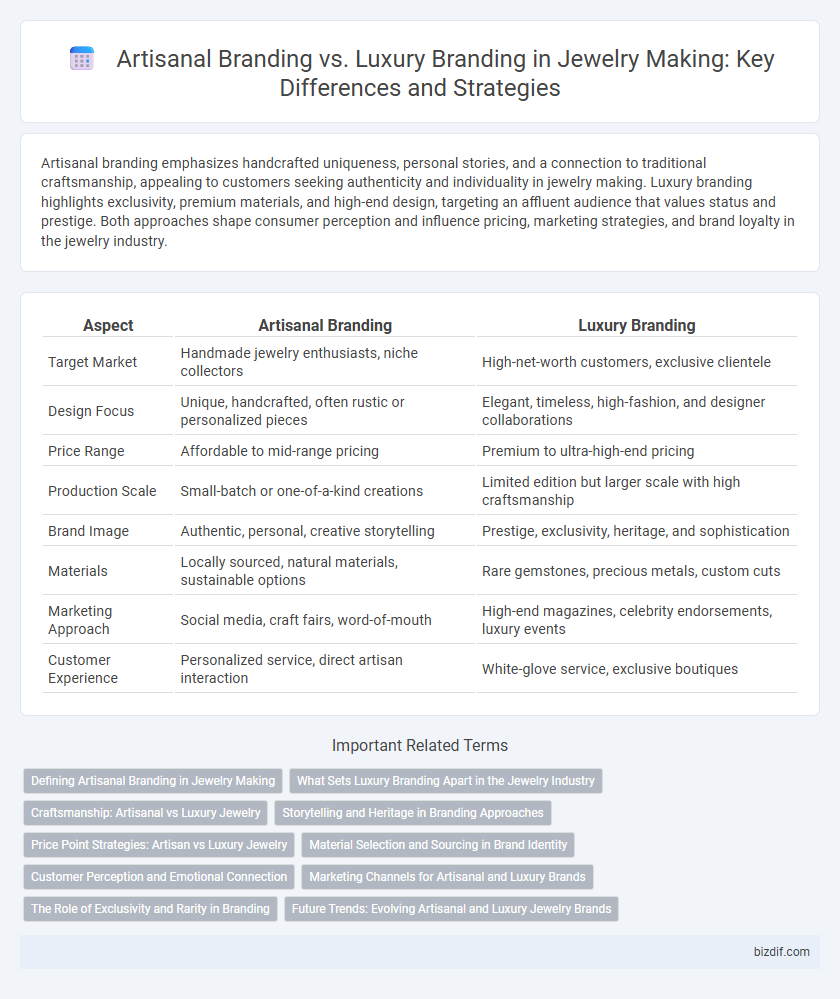Artisanal branding emphasizes handcrafted uniqueness, personal stories, and a connection to traditional craftsmanship, appealing to customers seeking authenticity and individuality in jewelry making. Luxury branding highlights exclusivity, premium materials, and high-end design, targeting an affluent audience that values status and prestige. Both approaches shape consumer perception and influence pricing, marketing strategies, and brand loyalty in the jewelry industry.
Table of Comparison
| Aspect | Artisanal Branding | Luxury Branding |
|---|---|---|
| Target Market | Handmade jewelry enthusiasts, niche collectors | High-net-worth customers, exclusive clientele |
| Design Focus | Unique, handcrafted, often rustic or personalized pieces | Elegant, timeless, high-fashion, and designer collaborations |
| Price Range | Affordable to mid-range pricing | Premium to ultra-high-end pricing |
| Production Scale | Small-batch or one-of-a-kind creations | Limited edition but larger scale with high craftsmanship |
| Brand Image | Authentic, personal, creative storytelling | Prestige, exclusivity, heritage, and sophistication |
| Materials | Locally sourced, natural materials, sustainable options | Rare gemstones, precious metals, custom cuts |
| Marketing Approach | Social media, craft fairs, word-of-mouth | High-end magazines, celebrity endorsements, luxury events |
| Customer Experience | Personalized service, direct artisan interaction | White-glove service, exclusive boutiques |
Defining Artisanal Branding in Jewelry Making
Artisanal branding in jewelry making emphasizes handcrafted techniques, unique designs, and authenticity, often highlighting the maker's personal story and cultural heritage. It leverages small-batch production and sustainable practices to appeal to consumers seeking originality and ethical value. This branding strategy contrasts with luxury branding by prioritizing craftsmanship and individuality over mass appeal and prestige.
What Sets Luxury Branding Apart in the Jewelry Industry
Luxury branding in the jewelry industry distinguishes itself through exceptional craftsmanship, exclusivity, and a heritage of prestige that artisanship alone may not provide. It emphasizes rare materials such as ethically sourced diamonds and precious gemstones, paired with meticulous design processes that create timeless pieces. This branding strategy leverages emotional appeal and status symbol value, positioning jewelry as an investment and legacy item beyond mere decoration.
Craftsmanship: Artisanal vs Luxury Jewelry
Artisanal jewelry emphasizes handcrafted techniques, unique designs, and the individual artisan's skill, often highlighting cultural heritage and personal storytelling. Luxury jewelry prioritizes impeccable craftsmanship combined with precious materials such as diamonds and gold, adhering to rigorous quality standards and brand prestige. The distinction lies in artisanal pieces showcasing creative authenticity while luxury brands deliver refined elegance and exclusivity.
Storytelling and Heritage in Branding Approaches
Artisanal branding in jewelry emphasizes authentic storytelling and cultural heritage, highlighting handcrafted techniques and the unique origin of each piece to create emotional connections with customers. Luxury branding focuses on exclusivity and timeless elegance, leveraging brand legacy and rich heritage narratives to enhance perceived value and status. Both approaches use storytelling to convey craftsmanship and legacy but differ in target audience and brand positioning strategies.
Price Point Strategies: Artisan vs Luxury Jewelry
Artisanal jewelry typically adopts a moderate price point strategy, reflecting handcrafted techniques, unique materials, and limited production that appeals to niche markets valuing authenticity. Luxury branding commands significantly higher prices, driven by exclusivity, premium gemstones, designer reputation, and extensive marketing efforts targeting affluent consumers. Price differentiation in jewelry making underscores distinct consumer psychology and value perception between artisanal craftsmanship and high-end luxury allure.
Material Selection and Sourcing in Brand Identity
Artisanal jewelry branding emphasizes ethically sourced, locally procured materials that reflect cultural heritage and craftsmanship, fostering a connection to authenticity and sustainability. Luxury branding prioritizes exclusive, rare gemstones and high-grade metals sourced from prestigious suppliers, underscoring rarity and opulence in the brand identity. Material selection and sourcing are pivotal in defining artisanal brands through transparency and tradition, while luxury brands leverage exclusivity and perfection to signify status and prestige.
Customer Perception and Emotional Connection
Artisanal jewelry branding emphasizes handcrafted uniqueness and authentic storytelling, fostering a deep emotional connection through perceived craftsmanship and personal touch. Luxury branding centers on exclusivity, prestige, and high-status symbols, shaping customer perception around aspirational lifestyles and premium quality. Both approaches influence consumer loyalty differently: artisanal appeals to values of individuality and tradition, while luxury targets desires for social recognition and elite identity.
Marketing Channels for Artisanal and Luxury Brands
Artisanal jewelry brands primarily leverage niche marketing channels such as social media platforms like Instagram and Pinterest to showcase handcrafted techniques and foster direct engagement with a community of craft enthusiasts. Luxury brands invest heavily in exclusive partnerships with high-end retailers, personalized VIP events, and sophisticated digital campaigns on platforms like Vogue Runway and luxury-focused websites to maintain an aura of prestige. Both utilize influencer collaborations, but artisanal brands prioritize authentic storytelling while luxury brands focus on elite endorsements to reinforce brand exclusivity.
The Role of Exclusivity and Rarity in Branding
Exclusivity and rarity serve as pivotal pillars in artisanal and luxury jewelry branding, defining their unique market positions. Artisanal branding emphasizes handcrafted uniqueness and limited production, appealing to consumers seeking personalized stories and cultural significance. Luxury branding leverages scarcity of high-value materials and prestigious craftsmanship to create an aura of opulence and elite status, driving demand through perceived rarity and exclusivity.
Future Trends: Evolving Artisanal and Luxury Jewelry Brands
Future trends in artisanal and luxury jewelry brands emphasize sustainability, personalized experiences, and digital innovation, transforming traditional craftsmanship into immersive customer engagements. Artisanal brands leverage blockchain for provenance transparency and integrate ethical sourcing to meet eco-conscious consumer demands. Luxury brands invest in augmented reality showrooms and AI-driven customization, blending heritage with technology to redefine exclusivity and craftsmanship in the digital age.
Artisanal branding vs Luxury branding Infographic

 bizdif.com
bizdif.com